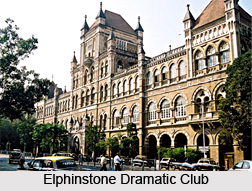 Elphinstone Dramatic Club was founded by Coonvarji Sorabji Nazir in 1861. He was a student of Elphinstone College. Initially using alumni of the college, it began by presenting English theatre. Some of the names can be mentioned as Shakespeare`s Merchant of Venice and Othello, Mervanji Wadia`s Honeymoon. Dr Dhanjisha Parekh, in the roles of Portia, Desdemona, and Zamora respectively, marked the turning point from stylization to realism in men`s portrayal of female characters. His brother Dr Nasarvanji Parekh was another partner. He eventually became a famous actor, director, and playwright. In the beginning the club staged shows at Grant Road Theatre. Elphinstone Theatrical Company turned professional in 1868, and after 1870 performed at Victoria Theatre. It is remembered for the Gujarati play `Karan Ghelo` in 1868. The young Framji Dadabhai Appu`s acting was lively and realistic as the hero, Karan, who was last Hindu king of Gujarat. He was a Parsi for first time attempted to speak correct Gujarati with proper intonation and stress. The troupe received help from Hindus to present a funeral realistically. Kavasji Contractor played the role of a woman named Rupasundari.
Elphinstone Dramatic Club was founded by Coonvarji Sorabji Nazir in 1861. He was a student of Elphinstone College. Initially using alumni of the college, it began by presenting English theatre. Some of the names can be mentioned as Shakespeare`s Merchant of Venice and Othello, Mervanji Wadia`s Honeymoon. Dr Dhanjisha Parekh, in the roles of Portia, Desdemona, and Zamora respectively, marked the turning point from stylization to realism in men`s portrayal of female characters. His brother Dr Nasarvanji Parekh was another partner. He eventually became a famous actor, director, and playwright. In the beginning the club staged shows at Grant Road Theatre. Elphinstone Theatrical Company turned professional in 1868, and after 1870 performed at Victoria Theatre. It is remembered for the Gujarati play `Karan Ghelo` in 1868. The young Framji Dadabhai Appu`s acting was lively and realistic as the hero, Karan, who was last Hindu king of Gujarat. He was a Parsi for first time attempted to speak correct Gujarati with proper intonation and stress. The troupe received help from Hindus to present a funeral realistically. Kavasji Contractor played the role of a woman named Rupasundari.
In the Urdu Alladin, wonderful trick scenes dazzled audiences. Some scenes can be mentioned as Alladin flying in the sky with a magical torch held spectators spellbound. The powerful dialogue, magical sequences, and fights on stage thrilled people. For some time Gujarati theatre followed this style. Dhanjibhai C. Master-Palkhiwala was the Elphinstone`s lead actor, whose entries and exits were unparalleled. In 1871-2, Amanat`s classic Indarsabha i.e. `Indra`s Court` was staged. In that play the colour of newly installed gas lights changed to match the colour of the fairy entering the court. Aram`s translation of Edulji Khorey`s Gujarati Nur Jahan proved remarkable productions in Urdu theatre history. Nazir eventually managed both the Elphinstone and Victoria Theatrical Company. Their performance of a children`s play should be noted as a progressive experiment. Among the Madan brothers who later took over die Elphinstone, the visionary Jamshedji Madan contributed to its development and progress. The last owner preferred Calcutta as its centre. This club existed till 1889.




















